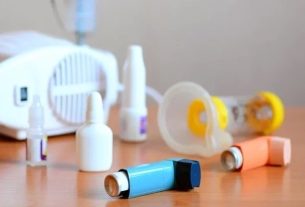Diabetes medications, such as oral antidiabetics or insulin, can cause side effects such as weight gain or loss, nausea, diarrhea or hypoglycemia, which are more common at the beginning of treatment.
Although these possible side effects exist, medications to treat diabetes are essential as they help control blood sugar, reducing the risk of complications such as kidney failure, skin ulcers, peripheral neuropathy or blindness.
Therefore, if any side effect appears, you should not stop the treatment or change the dose of the medicine on your own, but should inform the endocrinologist and undergo regular consultations and exams, so that the doctor can evaluate the treatment and, if necessary, change the medicine or change the doses.

Insulin side effects
The main side effects of insulin are:
1. Hypoglycemia
Hypoglycemia is the main side effect of any type of insulin, characterized by a marked reduction in glucose, resulting in symptoms such as tremor, weakness, cold sweat, pale skin, blurred vision, heart palpitations, chest pain, anxiety, mental confusion, difficulty to talk or drowsiness, for example. Know how to identify all the symptoms of hypoglycemia and what to do.
Hypoglycemia generally occurs when there is some dysregulation of the treatment, which may be a change in the diet that the person was used to, having gone for a long time without eating, using alcoholic beverages or some exercise or intense stress.
Therefore, to avoid this side effect and maintain constant glucose levels, it is essential to eat several small meals throughout the day, instead of eating a lot and few times, preferably with a diet guided by a nutritionist. If hypoglycemia is repetitive, it is important to consult with the doctor responsible for the treatment to adjust insulin doses and avoid this type of complication.
2. Seizures
Seizures can occur in the case of severe hypoglycemia, and can also cause other symptoms such as fainting or even coma.
In these cases, medical help should be sought immediately or the nearest emergency room should the person experience these symptoms. See how first aid for hypoglycemia is performed.
3. Injection site reactions
Applying insulin under the skin can cause allergic reactions at the injection site, such as redness, swelling, burning sensations or itching, which are generally temporary and improve with continued treatment.
In addition, a lump may appear under the skin, pain, irritation, bruising or bruises near the injection site may also occur.
It is important that the appropriate technique for applying insulin is guided by the doctor, and the application site must be rotated, that is, with each injection, it must be applied in different locations, such as the belly region, inner thigh or back of the arm.
Furthermore, the doctor responsible for the treatment should be informed if reactions occur at the injection site, so that they can be assessed and, if necessary, treatment can be indicated.
4. Lipodystrophy
Lipodystrophy is a side effect that can appear at the site of insulin application, characterized by changes in the sensation of the skin, such as thickening of the skin due to the accumulation of fat at the site, or a small depression in the skin resulting from the breakdown of fat at the site.
Therefore, it is important to know how to apply insulin correctly to prevent constant injections from causing damage to the skin or fatty tissue. See step by step how to apply insulin correctly.
Side effects of oral antidiabetics
There are several oral antidiabetics, in the form of tablets, to control type 2 diabetes, which can be taken alone or together with others.
Each class of hypoglycemic medications acts differently on the body and can cause different types of side effects, which vary with the type of medication, dose and sensitivity of each person, the main ones being:
1. Nausea and diarrhea
One of the main effects of oral antidiabetics is nausea and diarrhea, especially with the use of metformin, semaglutide, exenatide, liraglutide, repaglinide, acarbose, and sulfonylureas, such as glipizide, glibenclamide, gliclazide or glimepiride, for example.
You should consult your doctor to try to make adjustments that reduce the risk of these effects, such as taking the medication after eating or preferring long-acting medications, such as Metformin XR, for example.
If symptoms persist, it may be necessary to change the type of medication, with medical advice. Eating small meals several times a day can also help control this type of symptom.
2. Hypoglycemia
In addition to being a common side effect of insulin administration, hypoglycemia can also occur with oral antidiabetic drugs that stimulate the production of insulin by the pancreas, such as glibenclamide, glimepiride, gliclazide, chlorpropamide, repaglinide and nateglinide, for example.
To avoid hypoglycemia, it is important to never fast or go for a long time without eating while taking the medication, in addition to following a balanced diet divided into several small meals a day, avoiding going more than 3 hours without eating.
When you feel the first symptoms or identify someone with signs of hypoglycemia, you should sit down and offer foods rich in sugar or easily digestible carbohydrates, such as 1 glass of fruit juice, half a glass of water with 1 tablespoon of sugar or 1 sweet bread, for example. Consult your doctor to assess whether there is a need to adjust the dose or modify the medicine.
3. Excess gas
Excess gas is a very common side effect of acarbose, as it acts by reducing the absorption of glucose in the intestine. Furthermore, excess gas is also a complaint of people who use metformin.
To reduce this side effect, it is important to avoid foods with excess sugar, such as sweets, cakes and bread, or that produce a lot of gas, such as beans, cabbage and eggs, for example, in addition to having a diet rich in fiber.
4. Weight gain
Weight gain is common with the use of insulin or medications that increase the amount of insulin in the body, such as glibenclamide, glimepiride, gliclazide, repaglinide and nateglinide, or with those that cause fluid accumulation and swelling, such as pioglitazone and rosiglitazone. for example
Therefore, during treatment you must maintain a balanced diet, low in carbohydrates, fat and salt, in addition to practicing physical activity daily. The most recommended exercises are those that burn the most calories, such as walking, running or weight training. Find out which are the best exercises to lose weight.
5. Lack of appetite
This type of symptom can occur with the use of different medications, such as metformin, but is more intense in people who use semaglutide. For this reason, it is common to lose weight with the use of these types of medicines.
Therefore, it is important to maintain a balanced diet, without forgetting to eat meals at scheduled times, divided into small meals, several times a day. Check out some home remedies to combat lack of appetite.
6. Urinary tract infection
The increased risk of urinary infection occurs in a class of diabetes medications that increase the elimination of glucose in the urine, such as dapagliflozin, empagliflozin and canagliflozin. In this case, there is pain or a burning sensation when urinating and a strong urine smell. Know how to identify the symptoms of a urinary tract infection.
During treatment, you should drink plenty of fluids throughout the day, avoid foods with excess sugar, and take the antibiotic recommended by your doctor. If this change is persistent, you should talk to your doctor to assess the need to change your medication to control your diabetes.
It is common for people with diabetes to need to use more than one type of medication, therefore, in these cases, extra care must be taken to avoid side effects, paying attention to the correct dose, the recommended time, in addition to always maintaining balanced meals.

Sign up for our newsletter and stay up to date with exclusive news
that can transform your routine!
Warning: Undefined array key "title" in /home/storelat/public_html/wp-content/plugins/link-whisper-premium/templates/frontend/related-posts.php on line 12
Warning: Undefined array key "title_tag" in /home/storelat/public_html/wp-content/plugins/link-whisper-premium/templates/frontend/related-posts.php on line 13



